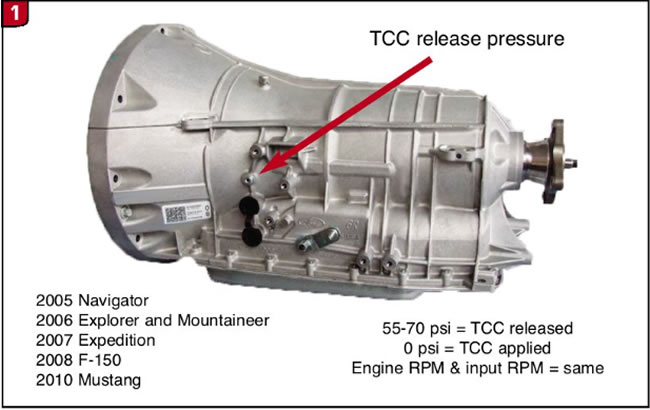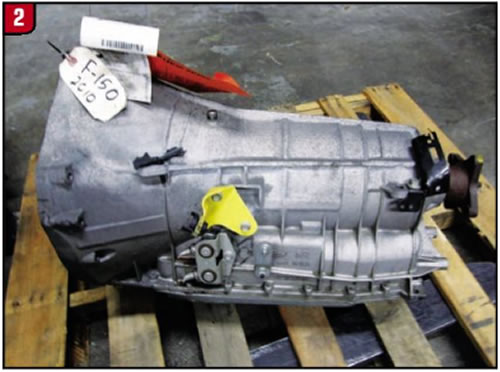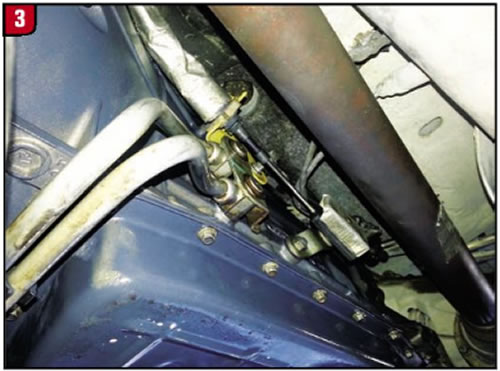
Shift Pointers
- Author: Wayne Colonna
- Subject Matter: 6R series
- Issue: TCC pressure
The 6R series transmission began with the 2005 Navigator followed by the 2006 Explorer and Mountaineer (4.6L V-8). The Expedition received it in 2007, 2008 for the F150 and 2010 for Mustang. These vehicles may come in with the transmission control indicator lamp (TCIL) illuminated along with a TCC slip code P0741 stored in memory. The malfunctioning indicator lamp (MIL) may or may not be illuminated.
Many of these vehicles have had defective OE converter-clutch linings causing the slip. Many of these have since been resolved so this issue doesn’t come up as much on ATSG’s technical help as it used to.
But when they do come in, we explain the way to verify a defective converter lining. It is by checking TCC pressure on the transmission’s one-and-only pressure tap (Figure 1). The idea is to clear the code to allow for the computer to apply the clutch. About 55-70 psi of pressure should be observed and go to 0 psi when full converter-clutch apply is commanded. If this is observed yet P0741 stores, the converter-clutch lining is defective. If engine rpm and input/turbine shaft rpm are observed during this test, when TCC is commanded on, engine rpm will remain higher than the ISS/TSS rpm.

When TCC operates correctly these two values would read the same.
This all sounds good in theory and is the best way to determine a slipping clutch. The setback here is when the tech goes to put a pressure gauge on the transmission. Once they see where the tap is located they politely say, “You gotta be kiddin’ me?!”

The one and only tap is covered by a cable bracket for the manual lever as you can see in figures 2 and 3.


This makes hooking up a gauge a real pain in the “you-know-what,” especially with the cooling lines and exhaust being in the way. As you can imagine, this test is rarely performed. We sometimes get the call back to hear the tech explaining how he/she couldn’t (wouldn’t) make the test because of this dilemma.
We then go on to provide the following options: assume the converter is bad and pull the unit to change it, or pull the valve body and inspect the TCC solenoid, the converter-release regulator valve and the bypass clutch-control regulator valve for wear and/or malfunctions. If the choice to inspect the valve body is selected and all looks good there, the input shaft sealing rings on the OD clutch drum assembly will then need to be looked at and so on. By this time they say, “You gotta be kiddin’ me?! ”
Typically, if this is a fresh job, a rebuilt transmission and another converter is offered to the customer as a resolution to the problem. If this is after a rebuild, it becomes an interesting issue, especially if all these items were addressed during a rebuild. Under these circumstances, all items related to TCC apply are still up for grabs making the pressure-test check a sure way to know the cause for P0741 to set.
Technicians note: When code P0741 sets, the computer will no longer apply the converter clutch. If a driver ignores the TCIL light, it is possible that the transmission may be overheated due to extended highway driving without converter clutch applied. If this is discovered, a more thorough repair may be needed.
Pressures during TCC Release:
- Park: 85 psi
- Reverse: 8 psi
- Neutral: 85 psi
- Drive: 70 psi
- 3 Position: 65 psi
- 2 Position: 65 psi
- 1 Position: 65 psi
- Pressure during TCC apply when driving: 0 psi














